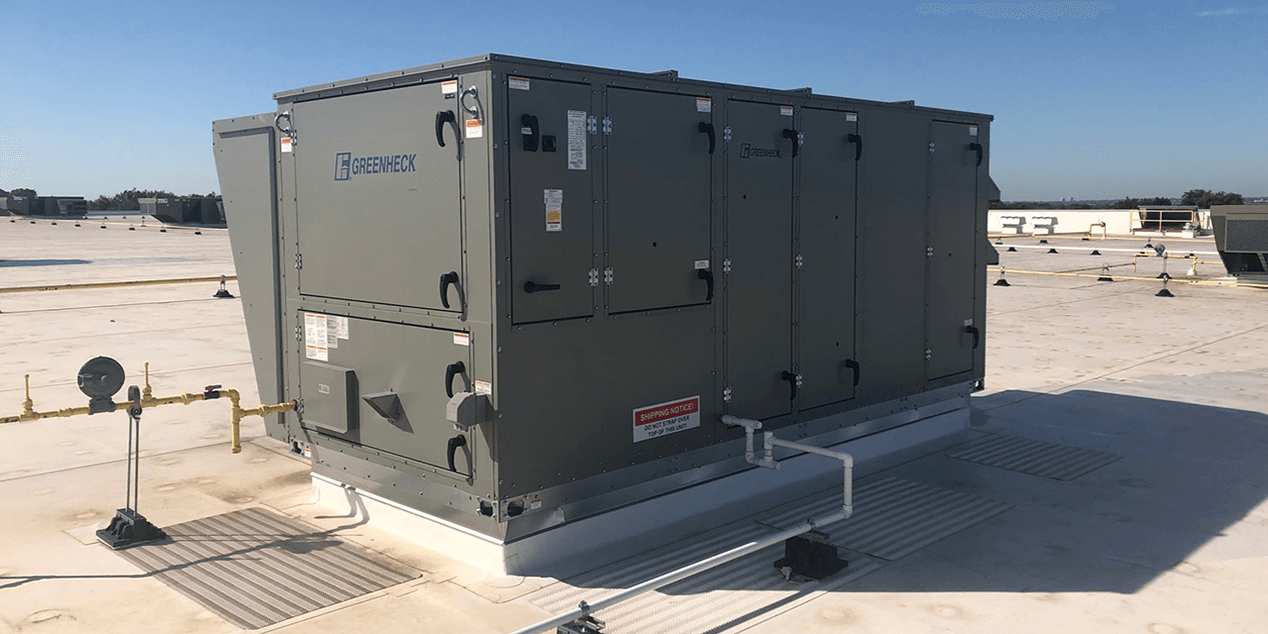What You Need to Know About DOAS And the New Efficiency Ratings

 |
| Figure 1: DOAS units provide conditioned air for a variety of applications including, education, healthcare, assisted living, hotels, kitchens, and restaurants. |
AHRI 920 is a performance rating standard that applies to DOAS ventilation units. This standard is relatively new in the industry. The first version is 2015 and the current (2020) version is finalized. Both versions of AHRI 920 contain efficiency ratings designed for units that dehumidify 100% outdoor air.
AHRI-920 Efficiency Ratings
AHRI 920-2015 contains two efficiency ratings: moisture removal efficiency (MRE) and integrated seasonal moisture removal efficiency (ISMRE). MRE is the dehumidification efficiency at a single operating condition. As shown in Equation 1, MRE is the ratio of supply air moisture removal to total power input.
 |
| Equation 1 |
ISMRE represents dehumidification efficiency over the entire dehumidification season. As shown in Equation 2, ISMRE consists of four MRE values tested at rating conditions A, B, C, and D. Each rating condition is a combination of the dry bulb and wet bulb temperatures shown in Table 1.
 |
| Equation 2 |
AHRI 920-2020 replaces ISMRE with two new efficiency ratings: ISMRE2 and ISMRE270. Supplemental heat may be used during dehumidification, to raise the supply air temperature to space-neutral conditions. These new efficiency ratings take the use of supplemental heat into account.
| Coil Entering Air Temperature | 2015 Rating Condition | 2020 Rating Condition | ||||||
| A | B | C | D | E | F | G | H | |
| Dry Bulb (°F) | 95 | 80 | 68 | 60 | 95 | 80 | 70 | 63 |
| Wet Bulb (°F) | 78 | 73 | 66 | 58 | 78 | 73 | 66 | 59 |
| Table 1: Rating conditions from AHRI 920. The evaporator and condenser coils are both exposed to these temperatures. | ||||||||
As shown in Table 1, rating conditions C and D have changed from the 2015 version. These changes are in response to testing difficulties. Labs were struggling to achieve and maintain the 2015 C and D conditions.
Use ISMRE2 for ventilation units that dehumidify without operating supplemental heat. Supplemental heat is a heat source (other than hot gas reheat) that raises the supply air temperature. Examples of supplement heat include gas furnaces, electric heating coils, and space heaters. The calculation for ISMRE2 is shown in Equation 3.
 |
| Equation 3 |
Use ISMRE270 for ventilation units that dehumidify while simultaneously operating supplemental heat. This rating includes the energy use of supplemental heat (not hot gas reheat) to raise the supply air temperature to 70°F. Note that this energy use is accounted for in the moisture removal efficiency 70 (MRE70) shown in Equation 4.
 |
| Equation 4 |
Comparing AHRI 920 and AHRI 340/360
EER is the cooling efficiency at a single operating condition. As shown in Equation 5, EER is the ratio of cooling capacity to total power input.
 |
| Equation 5 |
IEER represents cooling efficiency over the entire cooling season. As shown in Equation 6, IEER combines four EER values at rating conditions A, B, C, and D. The rating conditions are shown in Table 2.
 |
| Equation 6 |
| Rating Condition | Entering Air Temperature (°F) | |
| Condenser Coil | Evaporator Coil | |
| A | 95 DB | 80 DB / 67 WB |
| B | 81.5 DB | |
| C | 68 DB | |
| D | 65 DB | |
| Table 2: Rating conditions from AHRI 340/360-2019. The condenser coils are exposed to different temperatures. | ||
One difference between AHRI 340/360 and AHRI 920 is the evaporator coil entering air temperatures. AHRI 340/360 holds the evaporator coil air temperature entering constant while the condenser coil temperature changes. This is common for partial recirculation units that mix outdoor air with recirculated space air. AHRI 920 exposes the evaporator coil to the same temperatures as the condenser coil, which is typical of 100% outdoor air units. Also, note that the evaporator coil must provide a 55°F leaving dewpoint for dehumidification.
AHRI 340/360 applies to partial recirculation units while AHRI 920 applies to 100% outdoor air units providing dehumidification. Figure 2 shows the different evaporator coil conditions between AHRI 920 and AHRI 340/360.
Does COMcheck allow users to input ISMRE and ISMRE2 values?
COMcheck is a free web-based program that allows engineers to check HVAC system compliance with various codes and standards. Previous versions of COMcheck only allowed users to enter IEER ratings and not ISMRE ratings. This has changed with the most recent program update. Selecting ASHRAE 90.1-2016 allows users to select DX-DOAS unit or DX-DOAS unit with heat recovery for the cooling equipment type. Selecting either of these options does not require the input of cooling efficiency ratings as shown in Figure 3.
 |
| Figure 2: Comparison of IEER and ISMRE evaporator coil entering air temperatures. |
 |
| Figure 3: COMcheck allows the selection of DX-DOAS units when using ASHRAE 90.1-2016. Users are not required to enter efficiency ratings for these cooling equipment types as shown in red. |
Conclusion
AHRI 920 and AHRI 340/360 provide cooling efficiency ratings for commercial HVAC equipment. The ISMRE and ISMRE2 ratings in AHRI 920 apply to 100% outdoor air units that provide dehumidification. The IEER rating in AHRI 340/360 is for partial recirculation units. Using the correct values when selecting and specifying HVAC equipment will provide a more accurate estimate of the unit’s actual efficiency once installed.
Learn more about DOAS units, controls, and real-life applications.
DOAS HVAC

from